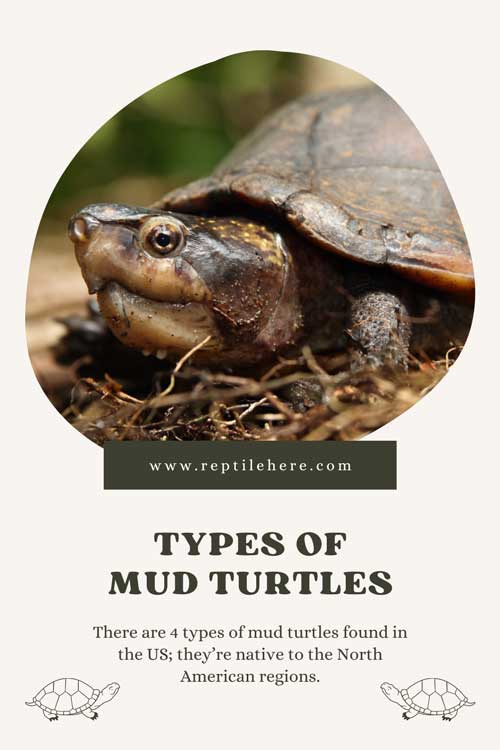Types of Mud Turtles
Mud turtles are so-called due to their tendency to live in sandy, wet, or muddy areas. There are 4 types of mud turtles found in the US; they’re native to the North American regions.
The turtles are generally small and make a good choice for pets for keeping both indoors and outdoors. Moreover, mud turtles are omnivorous and like feeding on fish, insects, and vegetation.
With a good diet and care, a pet mud turtle can live for up to 50 years!
This article takes you through all the mud turtles present in the US. For each turtle, we’ll cover basics such as physical appearance, average adult size, habitat, diet, conservation status, and more.
1. Mississippi Mud Turtle
Contents

- Scientific name: Kinosternon subrubrum
- Common name: Eastern Mud Turtle, Mud Turtle
- Family: Kinosternidae
- Size: 3 to 5 inches
- Lifespan: 50 years
- Conservation status: Least Concern
The Mississippi Mud turtle is a smaller aquatic turtle species is characterized by a smooth and unmarked shell. It has an incredible plain look, with its upper shell lacking any patterns. The carapace color ranges from dark yellow to black.
The lower side of the shell is also pretty plain, though it usually appears lighter on the upper part. The key distinction of this mud turtle is the stripes on its head which can be white or yellow in color.
One particular feature that sets this turtle apart from others and makes it easily identifiable is the hinges on its lower shell which form a “K” shape when viewed from the sides.
Just as its name suggests, this turtle lives in water bodies with a soft muddy, or sandy bottom. Thus, they can be found in marshes, swamps, and rivers.
Since this mud turtle is omnivorous, it eats meat, fish, snails, insects, and aquatic vegetation as well as plant matter on land.
Unlike other turtles, eastern mud turtles do not hibernate in the cold winter months. Instead, it does the opposite—it becomes dormant in the hot months of summer (this is known as aestivation).
2. Yellow mud turtle
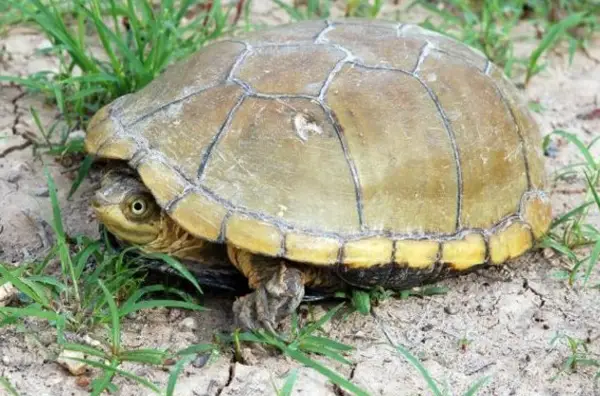
- Scientific name: Kinosternon arizonense
- Common name: Yellow Mud Turtle, Mud Turtle
- Family: Kinosternidae
- Size: 4-5 inches
- Lifespan: 40 years
- Conservation status: Least concern
The Yellow mud turtle is a species native to these states: Arkansas, Arizona, Colorado, Iowa, Kansas, New Mexico, Oklahoma, Illinois, Missouri, Nebraska, and Texas.
Potential habitats for this turtle include muddy pools, cattle tanks, irrigation ditches, sewer drains, and even cisterns!
This turtle will spend more time on land migrating to new water sources and is never picky about where it can stay.
It has its upper shell part flattened with colors varying from brown to black or olive. It also features dark brown edges around its scutes. The skin color is usually olive. Males have a sharp or horny end as a distinctive feature.
This yellow mud turtle is omnivorous like any other mud turtle. its diet is made up of a variety of foods including tadpoles, leeches, crayfish, fairy shrimp, and fish.
It will also eat frogs, slugs, and snails. And as an opportunistic feeder, it will also eat decaying animal and plant matter.
3. Sonora mud turtle
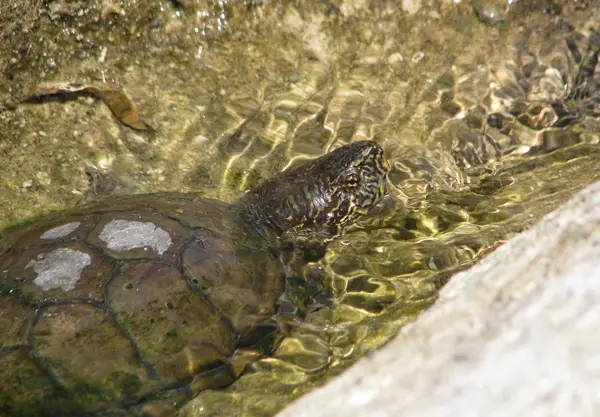
- Scientific name: Kinosternon sonoriense
- Common name: Sonora Mud Turtle, Mud Turtle
- Family: Kinosternidae
- Size: 5 to 7 inches
- Lifespan: 30 to 50 years
- Conservation status: Near threatened
The Sonoran mud turtle is pretty isolated and won’t be found in many areas apart from Arizona, Mexico, and New Mexico.
This turtle likes spending most of its time in water and is fond of creeks, streams, and even stock ponds in
A Sonora mud turtle is identified by its brown skin with yellow lines. The upper shell is olive-brown in color and has keels on it.
Similar to most other mud turtles, these turtles are omnivorous and like feeding on small insects and animals as well as vegetation.
Although this turtle species was once widespread, its range and population have been on the decline owing to habitat loss due to human intervention.
For this reason, the Sonora mud turtle has been labeled a “Near Threatened” species and is under special protection.
4. Eastern Mud Turtle
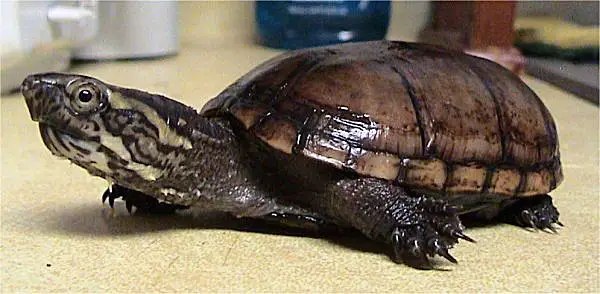
- Scientific name: Kinosternon subrubrum
- Common name: Eastern Mud Turtle, Mud Turtle
- Family: Kinosternidae
- Size: 3 to 5 inches
- Lifespan: 50 years
- Conservation status: Least Concern
The Eastern Mud turtle is commonly found in shallow waters including ditches, marshes, wet meadows, and swamps.
This smaller aquatic turtle species is characterized by a smooth and unmarked shell. It has an incredible plain look, with its upper shell lacking any patterns. The carapace color ranges from dark yellow to black.
The lower side of the shell is also pretty plain, though it usually appears lighter on the upper part. The key distinction of this mud turtle is the stripes on its head which can be white or yellow in color.
One particular feature that sets this turtle apart from others and makes it easily identifiable is the hinges on its lower shell which form a “K” shape when viewed from the sides.
Just as its name suggests, this turtle lives in water bodies with a soft muddy, or sandy bottom. Thus, they can be found in marshes, swamps, and rivers.
Since the eastern mud turtle is omnivorous, it eats meat, fish, snails, insects, and aquatic vegetation as well as plant matter on land.
Unlike other turtles, eastern mud turtles do not hibernate in the cold winter months. Instead, it does the opposite—it becomes dormant in the hot months of summer (this is known as aestivation).
5. Striped mud turtle
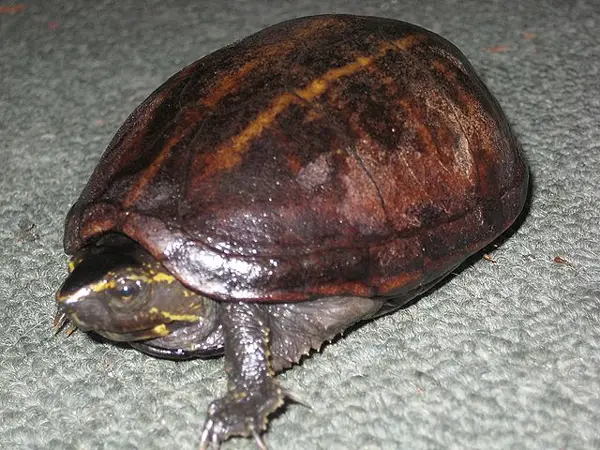
- Scientific name: Kinosternon baurii
- Common name: Striped Mud Turtle, Three-Striped Mud turtle
- Family: Kinosternidae
- Size: 4 to 5 inches
- Lifespan: 15 to 20 years
- Conservation status: Least Concern
The striped mud turtle is widespread throughout various US states including Tennessee, Florida, Georgia, North Carolina, Virginia, South Carolina, and Maryland.
You’ll most likely see them in the cypress swamps, ditches, and drainage canals.
Striped mud turtles usually have dark-brown oval-shaped shells, with 3 yellowish vertical stripes (hence their name).
The turtle species are quite easy to spot than other mud turtles as they spend more time on land than in water. They are unlike other mud turtles in that they sun themselves, forage for insects, and like resting out of the waters.
This mud turtle is omnivorous and eats snails, insects, fish, algae, carrion, and even plants. The turtle has also been observed eating dried krill.
Note that this turtle species is considered an imperiled species. Nonetheless, this small aquatic species is no longer considered under the status of Federal Endangered Status.
6. Rough-footed mud turtle

- Scientific name: Kinosternon hirtipes
- Other common names: Chihuahuan Mud turtle, Big Bend Mud turtle
- Family: Kinosternidae
- Size: 5 and 7 inches
- Lifespan: 30 to 50 years
- Conservation status: Least Concern
The rough-footed mud turtle is native to Texas and is pretty rare in this state. It is only found in southwestern areas, around the region of Big Bend (hence, it’s also known as the big bend mud turtle).
This mud turtle sports a domed shell ranging from olive to yellowish-brown. Its plastron and skin share the same color, so they easily blend in.
Just like other mud turtle species, this turtle has short and fleshy barbells that protrude from its chin and throat.
The big bend mud turtle of Texas is omnivorous and likes eating mollusks, small fish, invertebrates, and vegetation.
It prefers living in shallow waters where it can easily burrow into the sand or even silt at the bottom.
Conclusion
The mud turtles of the USA are yellow mud turtle, Mississippi mud turtle, eastern mud turtle, Sonora mud turtle, striped mud turtle, and rough-footed mud turtle.
These turtles are generally small and click between 3 and 7 inches in adult size. The females are usually larger than the males but are still within the “Small” size range.
Note that these mud turtles are good looking and their small sizes make them a popular choice of pets for many pet owners. They’re also omnivorous like most other turtle species.
Generally, these turtles require fairly low maintenance from their owners, which makes them great pet turtles.
